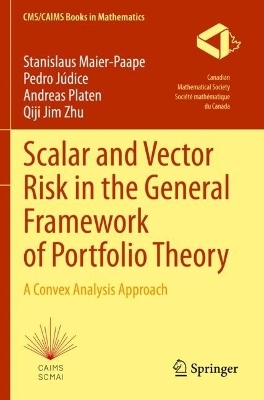
Scalar and Vector Risk in the General Framework of Portfolio Theory
Springer International Publishing (Verlag)
978-3-031-33323-1 (ISBN)
This book is the culmination of the authors' industry-academic collaboration in the past several years. The investigation is largely motivated by bank balance sheet management problems. The main difference between a bank balance sheet management problem and a typical portfolio optimization problem is that the former involves multiple risks. The related theoretical investigation leads to a significant extension of the scope of portfolio theories.
The book combines practitioners' perspectives and mathematical rigor. For example, to guide the bank managers to trade off different Pareto efficient points, the topological structure of the Pareto efficient set is carefully analyzed. Moreover, on top of computing solutions, the authors focus the investigation on the qualitative properties of those solutions and their financial meanings. These relations, such as the role of duality, are most useful in helping bank managers to communicate their decisions to the different stakeholders. Finally, bank balance sheet management problems of varying levels of complexity are discussed to illustrate how to apply the central mathematical results. Although the primary motivation and application examples in this book are focused in the area of bank balance sheet management problems, the range of applications of the general portfolio theory is much wider. As a matter of fact, most financial problems involve multiple types of risks. Thus, the book is a good reference for financial practitioners in general and students who are interested in financial applications. This book can also serve as a nice example of a case study for applied mathematicians who are interested in engaging in industry-academic collaboration.
Dr. Stanislaus Maier-Paape graduated from University of Augsburg. He had several guest positions at University of Utah (Postdoc), Georgia Institute of Technology (Heisenberg Fellow), and University of Regensburg (guest professor), before he got a permanent professorship at RWTH Aachen University in 2001 where he still teaches. He is author of four books on higher mathematics for electrical engineers and physicists, author and co-author of over 60 research articles and guest editor of two Risks Special Issues. From 2011 up to now he serves as a member of the jury of the VTAD Award. His research interests range from Dynamical Systems/PDE to Quantitative Finance/Risk Management. Dr. Pedro Júdice is a director at Montepio Bank in Lisbon and an integrated researcher in the Finance Group at ISCTE Business Research Unit. He started his banking career in 2003 as a quantitative research associate at JPMorgan Chase in London, and in 2006 he joined Montepio Bankas a director. Since then, he has had several different roles at this bank in market risk, non-core asset sales, strategic planning, asset-liability management, and financial sector research. Pedro has a Ph.D. from New York University (2003) and was a postdoctoral research associate at the University of Chicago Booth School of Business (2011-2012). He was an invited assistant professor at ISCTE Business School in Lisbon, a Visiting Professor at Western Michigan University (Feb 2022-Apr 2022), and served as a regional co-director for the Global Association of Risk Professionals. His academic research has focused on practical banking problems, and he has published in the Journal of Banking and Finance and Expert Systems with Applications, among other journals. Dr. Andreas Platen graduated in mathematics from RWTH Aachen University in2018 and was postdoc at the same university until 2019. Since 2019 he is a software developer at nokra GmbH. Hehas published several research papers in numerical analysis, quantitative finance and portfolio theory. Dr. Qiji Jim Zhu is a Professor of Mathematics at Western Michigan University. He also held visiting positions at National University of Singapore, Singapore, Courant Institute, New York University, University of Newcastle, Australia, Aachen University, Germany, Fudan University, China, and Peking University, China. Dr. Zhu's research fields are financial mathematics and variational analysis. He has co-authored two research monographs, one text book and over 70 research papers in these fields and served in various roles as editor, referee and reviewer for related journals, conference proceedings and books.
Preface.- Introduction.- Efficient Portfolios for Scalar Risk Functions.- Efficient Portfolios for Vector Risk Functions.- Application Examples.- Conclusion.- Appendix A Convex Programming Problems.- References.- Index.
| Erscheinungsdatum | 07.09.2024 |
|---|---|
| Reihe/Serie | CMS/CAIMS Books in Mathematics |
| Zusatzinfo | XI, 228 p. 32 illus., 1 illus. in color. |
| Verlagsort | Cham |
| Sprache | englisch |
| Maße | 155 x 235 mm |
| Gewicht | 371 g |
| Themenwelt | Mathematik / Informatik ► Mathematik ► Angewandte Mathematik |
| Wirtschaft | |
| Schlagworte | Asset Allocation • Bank balance sheet problems • Convex analysis application • Convex programming / duality • General framework of portfolio theory • Multiple risks • portfolio optimization • Topological structure of the efficient frontier |
| ISBN-10 | 3-031-33323-3 / 3031333233 |
| ISBN-13 | 978-3-031-33323-1 / 9783031333231 |
| Zustand | Neuware |
| Haben Sie eine Frage zum Produkt? |
aus dem Bereich


